
Blue-winged Olives
Baetis
Tiny Baetis mayflies are perhaps the most commonly encountered and imitated by anglers on all American trout streams due to their great abundance, widespread distribution, and trout-friendly emergence habits.
Featured on the forum

This seems to be a young larva of Limnephilus. Although not clear in the picture, several ventral abdominal segments have chloride epithelia.

Troutnut is a project started in 2003 by salmonid ecologist Jason "Troutnut" Neuswanger to help anglers and
fly tyers unabashedly embrace the entomological side of the sport. Learn more about Troutnut or
support the project for an enhanced experience here.
Identification: Key to Genera of Limnephilidae Larvae, Couplet 35
Identification: Key to Genera of Limnephilidae Larvae, Couplet 35
Error: Tried to access a key that isn't live.
Adapted from Merritt R.W., Cummins, K.W., and Berg, M.B. (2019)
This couplet refers figures (usually designated 'sf') from this source.
You will need the source (make sure to get the same edition!) to see them.
This couplet refers figures (usually designated 'sf') from this source.
You will need the source (make sure to get the same edition!) to see them.
| Option 1 | Option 2 |
|---|---|
Dorsum of head light brownish yellow with numerous discrete, small, dark spots (sf 19.312) 
| Dorsum of head with varied markings, usually darker than at left |
Case cylindrical, made of longitudinally arranged sedge or similar leaves (sf 19.337) 
| Cases of wide range of shapes and materials (sf 19.25, 19.442a–19.442c) |
| North | Widespread except not deep Southeast (i.e., not east of Texas or south of Arkansas and South Carolina) |
1 Example Specimen
This is a striking caddis larva with an interesting color pattern on the head. Here are some characteristics I was able to see under the microscope, but could not easily expose for a picture:
- The prosternal horn is present. - The mandible is clearly toothed, not formed into a uniform scraper blade. - The seems to be only 2 major setae on the ventral edge of the hind femur. - Chloride epithelia seem to be absent from the dorsal side of any abdominal segments. Based on these characteristics and the ones more easily visible from the pictures, this seems to be Grammotaulius. The key's description of the case is spot-on: "Case cylindrical, made of longitudinally arranged sedge or similar leaves," as is the description of the markings on the head, "Dorsum of head light brownish yellow with numerous discrete, small, dark spots." The spot pattern on the head is a very good match to figure 19.312 of Merritt R.W., Cummins, K.W., and Berg, M.B. (2019). The species ID is based on Grammotaulius betteni being the only species of this genus known in Washington state. | 5 Example Specimens |
| Grammotaulius | Limnephilus |
Adapted from Merritt R.W., Cummins, K.W., and Berg, M.B. (2019)
The current couplet is highlighted with darker colors and a icon, and couplets leading to this point have a icon.
Leads to Cryptochia:
- Anterior margin of pronotum densely fringed with long hairs, and dorsum of head flat and with bands of dense scale hairs (sf 19.272)
- Case tapered, depressed, made of transverse bits of wood and bark (sf 19.480) West
Cryptochia
Leads to Couplet 2:
- Anterior margin of pronotum and dorsum of head without dense hairs, or hairs not of type or arrangement as described at left
Couplet 2
Leads to Couplet 3:
- Most abdominal gills single
Couplet 3
Leads to Couplet 18:
- Most dorsal and ventral gills multiple However, lateral gills sometimes single (sf 19.332)
Couplet 18
Leads to Ecclisomyia:
- Metanotal sa2 sclerites large; distance between sa2 sclerites no more than twice the maximum dimension of single sa2 sclerite (sf 19.276)
- Left and right metanotal sa1 sclerites distinct, not fused together
- Case a slender, straight, scarcely tapered tube, made of coarse rocks often with long plant material attached (sf 19.431) West
Leads to Couplet 4:
- Metanotal sa2 sclerites small; distance between sa2 sclerites more than twice maximum dimension of single sa2 sclerite
- Metanotal sa1 sclerites sometimes but not always fused into a single sclerite (sf 19.280)
Couplet 4
Leads to Phanocelia
(Phanocelia canadensis):
(Phanocelia canadensis):
- Each mesonotal plate wider than long, shorter mesally than laterally (sf 19.278)
- Abdominal segment VIII with transverse posterodorsal line of slender, closely spaced setae (sf 19.275)
- Case of short pieces of Sphagnum moss laid transversely (sf 19.341) North
Phanocelia
(Phanocelia canadensis)
(Phanocelia canadensis)
Leads to Couplet 5:
- Mesonotal plates of varying width, but length nearly same mesally and laterally
- Abdominal segment VII with or without posterodorsal line of setae, but less dense than at left, if present (sf 19.306)
Couplet 5
Leads to Couplet 6:
- 1 or 2 sclerites adjacent to base of each lateral hump of abdominal segment I (sf 19.281–19.286); sclerites often only lightly pigmented and difficult to see, but distinguishable by relatively shinier surfaces
Couplet 6
Leads to Couplet 13:
- No sclerites adjacent to lateral humps of abdominal segment I
Couplet 13
Leads to Chyranda
(Chyranda centralis):
(Chyranda centralis):
- Large single sclerite at base of each lateral hump of abdominal segment I enclosing posterior half of hump and extending posterodorsad as irregular lobe
- Case of leaves or bark formed into flattened tube with seams along narrow lateral flanges North, West
Leads to Couplet 7:
- 1 or 2 small sclerites without irregular lobes at base of each lateral hump of abdominal segment I (sf 19.283, 19.284)
Couplet 7
Leads to Couplet 8:
- 1 long sclerite at posterior edge of base of each lateral hump of abdominal segment I (sf 19.281, 19.284)
Couplet 8
Leads to Couplet 10:
- 2 or more sclerites at base of each lateral hump on abdominal segment I (sf 19.283, 19.285)
Couplet 10
Leads to Homophylax:
- Sclerite at base of each lateral hump of abdominal segment I only half as tall as basal width of hump (sf 19.284)
- Case smooth, thin-walled, nearly straight, little-tapered tube, made of irregularly arranged bark pieces (sf 19.433) or occasional flat rocks, rarely 3-sided West
Homophylax
Leads to Couplet 9:
- Sclerite at base of each lateral hump of abdominal segment I nearly as tall as basal width of hump (sf 19.281)
Couplet 9
Leads to Hydatophylax:
- Left and right metanotal sa1 sclerites fused into a single sclerite (sf 19.280)
- Abdominal sternum II with chloride epithelium (in which case abdominal segment IX with only a single seta on each dorsal sclerite, similar to sf 19.287, Hydatophylax argus, eastern North America) or without chloride epithelium (in which case abdominal segment IX with tuft of 3–6 setae, sf 19.287 inset, Hydatophylax hesperus, western North America).
- Case of wood or leaves in irregular outline (sf 19.434)
- Widespread except not Southwest
Leads to Pycnopsyche:
- Metanotal sa1 sclerites not fused, although often contiguous (sf 19.277)
- Abdominal sternum II without chloride epithelium and abdominal segment IX with only single seta on each side of dorsal sclerite (sf 19.287)
- Case of twigs, gravel, or leaves, variously shaped (sf 19.435)
- Central, East, North
Leads to Couplet 11:
- 2 small ring sclerites posterodorsally at base of each lateral hump of abdominal segment I (sf 19.285)
- Case tubular, slightly curved, tapered, made of mostly of rocks with some small pieces of wood incorporated (sf 19.436)
Couplet 11
Leads to Couplet 12:
- 2 or more sclerites dissimilar in shape at base of each lateral hump (sf 19.283)
Couplet 12
Leads to Desmona:
- Sclerotized parts more reddish brown
- Small secondary setae numerous on head
- Metanotum with setae scattered between sclerites bearing primary setal areas
- Abdominal segment VII usually lacking posterodorsal gills
- California
Desmona
Leads to Monophylax
(Monophylax mono):
(Monophylax mono):
- Sclerotized parts darker brown (tending to become reddish brown in preserved specimens)
- Secondary setae absent on head
- Metanotal setae between primary setal area sclerites reduced or absent
- Abdominal segment VII usually with posterodorsal gills
- West
Monophylax
(Monophylax mono)
(Monophylax mono)
Leads to Psychoglypha:
- 1 or 2 small rounded posterodorsal sclerites and 1 long dorsal sclerite at base of each lateral hump of abdominals segment I (sf 19.283) or dorsal area at base of hump with several small discrete sclerites, 1 surrounding each seta
- Case rough, straight, untapered tube, made of rocks and wood fragments (sf 19.24), sometimes with trailing pieces of cases of other caddisflies attached (sf 19.437) North, West
Leads to Couplet 15:
- 1 irregular posterior sclerite and 1 irregular dorsal sclerotized area surrounding bases of 2–3 setae (sf 19.286)
Couplet 15
Leads to Philocasca:
- Anterior margin of pronotum with flat scale hairs (sf 19.288)
- Dorsum of head flat (sf 19.288)
- Case slightly curved, coarse, made of minerals (sf 19.438) Northwest
Philocasca
Leads to Couplet 14:
- Anterior margin of pronotum normal setae instead of flat scale hairs (sf 19.290)
- Dorsum of head usually convex (sf 19.290), except flat only in western Pseudostenophylax edwardsi (sf 19.292)
Couplet 14
Leads to Couplet 15:
- Metanotal sa1 and sa2 distinct, separated by gaps free of setae. (sf 19.293, 19.294)
Couplet 15
Leads to Couplet 17:
- Metanotal sa1 and sa2 connected by contiguous longitudinal band of setae on each side of meson (sf 19.291)
Couplet 17
Leads to Grensia
(Grensia praeterita):
(Grensia praeterita):
- Pronotum covered with fine spines (sf 19.293 inset)
- Case of plant and rock fragments (sf 19.439), sometimes with snail opercula Northwest (Arctic)
Grensia
(Grensia praeterita)
(Grensia praeterita)
Leads to Couplet 16:
- Pronotum smooth and shiny, without fine spines (sf 19.294)
Couplet 16
Leads to Clostoeca
(Clostoeca disjuncta):
(Clostoeca disjuncta):
- Mesonotal sclerites each about as long as wide (sf 19.294)
- Case of leaf pieces with wide flanges at each side of depressed tube (sf 19.511a, 19.511b)
- Northwest
Leads to Chilostigma
(Chilostigma itascae):
(Chilostigma itascae):
- Mesonotal sclerites each wider than long (sf 19.295)
- Case straight, made irregularly of small pieces of leaves and bark
- Minnesota
Chilostigma
(Chilostigma itascae)
(Chilostigma itascae)
Leads to Ecclisocosmoecus
(Ecclisocosmoecus scylla):
(Ecclisocosmoecus scylla):
- Head and pronotum strongly inflated and with pebbled texture (sf 19.289)
- Case smooth, tapered, made of small rocks (sf 19.340)
- Northwest
Ecclisocosmoecus
(Ecclisocosmoecus scylla)
(Ecclisocosmoecus scylla)
Leads to Pseudostenophylax:
- Head and pronotum not usually inflated (sf 19.290), although dorsum of head flat in western species (sf 19.292); sclerotized areas not pebbled
- Case smooth, tapered, curved, made of rocks (sf 10.184, 19.23)
- Central, East, Northwest
Pseudostenophylax
Leads to Couplet 19:
- Most gills with 2 or 3 branches, none with more than 4
Couplet 19
Leads to Couplet 40:
- At least some gills with more than 4 branches
Couplet 40
Leads to Couplet 20:
- Dorsum of head with 2 bands of contrasting color extending from coronal suture to bases of mandibles (sf 19.296) and/or narrowed posterior portion of frontoclypeal apotome with 3 light areas: 1 along each side and 1 at posterior extremity (sf 19.297)
Couplet 20
Leads to Couplet 26:
- Dorsum of head lacking bands or other well-defined, contrasting areas, usually uniform in color or with prominent light or dark spots only at points of muscle attachment (sf 19.311)
Couplet 26
Leads to Couplet 21:
- Dorsum of head with prominent dark bands on light background, lateral bands extending from coronal suture to base of each mandible, median band on frontoclypeus (sf 19.296)
Couplet 21
Leads to Couplet 23:
- Dorsum of head lacking dark lateral bands, but narrowed posterior part of frontoclypeus with 3 light areas: 1 along each side and 1 at posterior extremity (sf 19.297)
Couplet 23
Leads to Nemotaulius
(Nemotaulius hostilis):
(Nemotaulius hostilis):
- Dark dorsal bands on head fused at junction of coronal and frontoclypeal sutures to form U-shaped marking (sf 19.298)
- Pronotum with narrow bands along anterior border and across dorsum (sf 19.298)
- Case of leaf pieces arranged transversely or longitudinally (sf 19.440) North
Leads to Couplet 22:
- Dark dorsal bands on head extended posterad beyond junction of coronal and frontoclypeal sutures to form V-shaped marking (sf 19.296)
- Pronotal markings variable
Couplet 22
Leads to Halesochila
(Halesochila taylori):
(Halesochila taylori):
- Chloride epithelia present dorsally (as well as dorsolaterally and ventrally) on several abdominal segments (sf 19.299)
- Rough, tubular case of wood or leaf fragments, sometimes 3-sided, changed to fine gravel before pupation Northwest
Halesochila
(Halesochila taylori)
(Halesochila taylori)
Leads to Couplet 25:
- Chloride epithelia absent dorsally (present ventrally and sometimes dorsolaterally)
Couplet 25
Leads to Clistoronia:
- Abdominal sternum I usually with more than 100 setae overall, with setal areas merged (sf 19.300)
- Small spines on head and pronotum (sf 19.297)
- Short, stout setae on lateral sclerite of each anal proleg (sf 19.305)
- Case cylindrical, made usually of irregular pieces of twigs and bark (sf 19.441b), sometimes small rocks (sf 19.441a) West
Clistoronia
Leads to Couplet 24:
- Abdominal sternum I with fewer than 100 setae overall, with setal areas discrete
- Usually without spines on head and pronotum
- Usually without short, stout setae on lateral sclerite of anal proleg
Couplet 24
Leads to Asynarchus:
- Chloride epithelia present dorsally, laterally, and ventrally on most abdominal segments (similar to sf 19.299)
- Case of plant and rock materials (sf 19.343) North
Asynarchus
Leads to Couplet 25:
- Chloride epithelia absent dorsally, may be present dorsolaterally but always present ventrally on most abdominal segments
Couplet 25
Leads to Limnephilus:
- Mesothoracic femora each with 2 major setae situated near midpoint of femur (sf 19.301)
- Cases of wide range of shapes and materials (sf 19.25, 19.442a–19.442c)
- Widespread except not deep Southeast (i.e., not east of Texas or south of Arkansas and South Carolina)
Leads to Philarctus
(Philarctus bergrothi):
(Philarctus bergrothi):
- Mesothoracic femora each with 1 major seta 1/4 distance from base (remote from midpoint of femur) and 1 major seta near midpoint of femur (sf 19.302)
- Case of fine sand, sedge seeds, or snail shells
- Northwest
Philarctus
(Philarctus bergrothi)
(Philarctus bergrothi)
Leads to Couplet 27:
- Femur of each hind leg with 2 major setae on ventral edge—these setae sometimes unequal in length (sf 19.303)
Couplet 27
Leads to Couplet 36:
- Femur of each hind leg with more than 2 major setae on ventral edge (sf 19.304)
Couplet 36
Leads to Couplet 28:
- Pronotum, especially anterior margin (sf 19.307), and lateral sclerite of each anal proleg (sf 19.305) both with short, stout setae
Couplet 28
Leads to Couplet 29:
- Pronotum usually without short, stout setae, and lateral sclerite of each anal proleg always without such setae
Couplet 29
Leads to Glyphopsyche:
- Tibiae and tarsi of all legs each with dark, contrasting band (sf 19.303)
- Case cylindrical, made of sand, twigs, and bark (sf 19.443)
- Central, North
Glyphopsyche
Leads to Couplet 30:
- Chloride epithelia present dorsally on at least some abdominal segments (as in sf 19.299)
Couplet 30
Leads to Couplet 33:
- Chloride epithelia absent dorsally on abdominal segments
Couplet 33
Leads to Arctopora:
- Metanotal sa2 with few setae, usually 2, and no sclerite (sf 19.308)
- Case smooth, cylindrical, made of long sedge or grass pieces North
Arctopora
Leads to Couplet 31:
- Metanotal sa2 with more than 2 setae and with sclerite (sf 19.311)
Couplet 31
Leads to Couplet 32:
- Dorsum of head with numerous large spots often coalescing in places into diffuse blotches, or small discrete spots, especially on frontoclypeal apotome (sf 19.311)
Couplet 32
Leads to Asynarchus:
- Dorsum of head with varied markings, but not spots
- Case of plant and rock materials (sf 19.343) North
Asynarchus
Leads to Anabolia:
- Anterolateral corners of pronotum each with small patch of spines (sf 19.87, 19.88, 19.311)
- Case cylindrical, made of plant materials (sf 19.338), sometimes 3-sided Widespread
Anabolia
Leads to Couplet 35:
- Anterolateral corners of pronotum usually lacking patches of spines
Couplet 35
Leads to Platycentropus:
- Prosternal horn extending beyond head capsule to mentum of labium (sf 19.89, 19.309)
- Case cylindrical, made of transverse, narrow, projecting pieces of plant material (sf 19.445) Widespread
Leads to Couplet 34:
- Prosternal horn extending only to distal edge of head capsule (sf 19.310)
Couplet 34
Leads to Sphagnophylax
(Sphagnophylax meiops):
(Sphagnophylax meiops):
- Chloride epithelia absent laterally, but present ventrally on abdominal sterna II-VII
- Mesonotal sa1 with single seta (sf 19.314)
- Ventral abdominal setal area with a single pair of setae in the sa2 position (sf 19.316)
- Case of piece of sedge leaves arranged lengthwise and irregularly (sf 19.342) Northwest Territories, Yukon Territory (Arctic tundra)
Sphagnophylax
(Sphagnophylax meiops)
(Sphagnophylax meiops)
Leads to Couplet 35:
- Chloride epithelia occasionally present laterally, always present ventrally on abdominal sterna II-VII
- Mesonotal sa1 usually with more than 1 seta
- Ventral abdominal setal area usually with 2 or more setae in the sa2 position (sf 19.315)
Couplet 35
Couplet 35 (You are here)
Leads to Grammotaulius:
- Dorsum of head light brownish yellow with numerous discrete, small, dark spots (sf 19.312)
- Case cylindrical, made of longitudinally arranged sedge or similar leaves (sf 19.337)
- North
Leads to Limnephilus:
- Dorsum of head with varied markings, usually darker than at left
- Cases of wide range of shapes and materials (sf 19.25, 19.442a–19.442c)
- Widespread except not deep Southeast (i.e., not east of Texas or south of Arkansas and South Carolina)
Leads to Couplet 37:
- Tibiae with several pairs of stout, spur-like setae (sf 19.317)
Couplet 37
Leads to Couplet 38:
- Tibiae each with only 1 pair of stout, spur-like setae at apex (sf 19.318)
Couplet 38
Leads to Allocosmoecus
(Allocosmoecus partitus):
(Allocosmoecus partitus):
- Abdominal tergum I with transverse row of setae posterior to median dorsal hump (sf 19.319)
- Scale hairs on dorsum of head (sf 19.325)
- Abdominal sternum II with 2 chloride epithelia (sf 19.323)
- Case irregularly outlined, made of small pebbles arranged in slightly curved and flattened cylinder (sf 19.335)
- Northwest
Allocosmoecus
(Allocosmoecus partitus)
(Allocosmoecus partitus)
Leads to Dicosmoecus:
- Abdominal tergum I usually lacking setae posterior to median hump (sf 19.320)
- Dorsum of head without scale hairs
- Abdominal sternum II with single chloride epithelium (sf 19.324), 3 epithelia (smaller epithelia laterally), or without epithelia
- Case of final instar of fine gravel, slightly depressed (sf 19.336, 19.508); case of younger larvae with plant materials
- West
Leads to Amphicosmoecus
(Amphicosmoecus canax):
(Amphicosmoecus canax):
- Left and right metanotal sa1 sclerites usually fused in the middle into a single sclerite (sf 19.321), but occasionally separated by small gap
- Case of hollow twig with ring of bark pieces anteriorly (sf 19.446a) or case entirely of wood fragments (sf 19.446b) West
Amphicosmoecus
(Amphicosmoecus canax)
(Amphicosmoecus canax)
Leads to Couplet 39:
- Metanotal sa1 sclerites clearly separate (sf 19.322)
Couplet 39
Leads to Eocosmoecus:
- Pronotum anteriorly with erect submarginal setae widely spaced, especially mesally, and with some short, stout, marginal setae among fine marginal hairs (sf 19.328)
- Abdominal tergum VII with a single long seta on either side of midline posterodorsally, sometimes each side with 1 or 2 much smaller setae (sf 19.330)
- Lateral abdominal gills usually lacking from segment V, sometimes from IV or terminating with anterior position of segment IV
- Case of final instar made of stout pieces of wood (sf 19.447) or of fine rock fragments (sf 19.448); cases of earlier instars made of pliable plant materials
- Northwest
Eocosmoecus
Leads to Onocosmoecus:
- Pronotum anteriorly with submarginal setae more closely spaced, especially submesally, and all of similar length and thickness, without short, stout setae among fine marginal hairs (sf 19.329)
- Abdominal tergum VII with 1–5 long setae on either side of midline posterodorsally (sf 19.331)
- Lateral abdominal gills terminating with anterior portion of segment V
- Case of pieces of wood and bark (sf 19.449)
- North, West
Leads to Ironoquia:
- Femora of middle and hind legs each with approximately 5 major setae along ventral edge (sf 19.326)
- Case curved, scarcely tapered, made of wood, bark, twigs, and leaves (sf 19.339, 19.509, 19.510) or of sand Central, East
Leads to Couplet 41:
- Femora of middle and usually hind legs each with 2 major setae along ventral edge (sf 19.327)
Couplet 41
Leads to Lenarchus:
- Metanotum with all setae confined to the metanotal setal warts (sf 19.333)
- Case cylindrical, made of longitudinally arranged lengths of sedge leaves or of fragments of bark and leaves (sf 19.450) North, West
Lenarchus
Leads to Couplet 42:
- Metanotum with at least a few setae between metanotal setal warts (sf 19.334)
Couplet 42
Leads to Psychoronia:
- Surface of head without short, fine, acuminate spines
- West
Psychoronia
Leads to Couplet 43:
- Surface of head with short, fine, acuminate spines
Couplet 43
Leads to Crenophylax
(Crenophylax sperryi):
(Crenophylax sperryi):
- Pronotal surface minutely pebbled, without short spines
- Southwest
Crenophylax
(Crenophylax sperryi)
(Crenophylax sperryi)
Leads to Hesperophylax:
- Pronotal surface with numerous short spines
- North, West
Start a Discussion of this Couplet
References
- Merritt R.W., Cummins, K.W., and Berg, M.B. 2019. An Introduction to the Aquatic Insects of North America (Fifth Edition). Kendall/Hunt Publishing Company.





